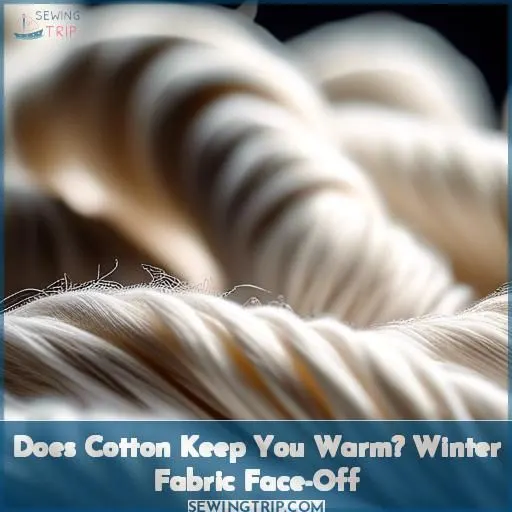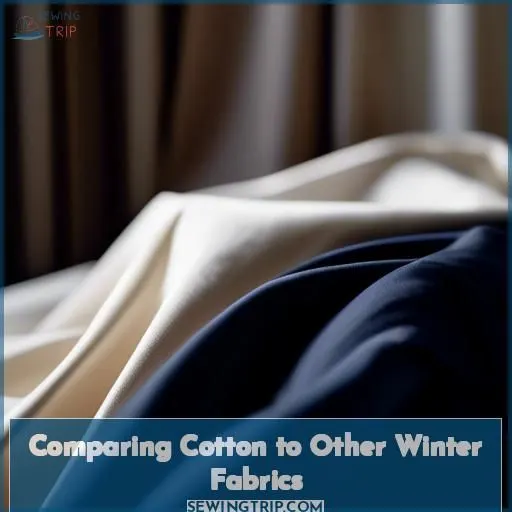This site is supported by our readers. We may earn a commission, at no cost to you, if you purchase through links.
Cotton can indeed keep you warm in winter, but it requires careful layering and care. Opt for moisture-wicking base layers, windproof and waterproof outer layers, and thick cotton attire for insulation. Wool and fleece may provide more warmth, but cotton is breathable and suitable for delicate skin.
You can also layer cotton sweaters and accessorize with cotton beanies and flannel blankets for added comfort.
Table Of Contents
Key Takeaways
- Cotton can keep you warm in winter, but it requires careful layering and care.
- Opt for moisture-wicking base layers, windproof and waterproof outer layers, and thick cotton attire for insulation.
- Wool and fleece may provide more warmth, but cotton is breathable and suitable for delicate skin.
- Tips on How to Use Cotton Fabric Products include wearing cotton for winter, caring for cotton in winter, comparing cotton to other winter fabrics, and using cotton in winter fashion.
Does Cotton Keep You Warm?
Yes, cotton can keep you warm, especially when used in specific types of garments such as cotton fleece, flannel, or cotton-acrylic blends. These materials can sustain body warmth in winter, and cotton is often used in weather-resistant clothing to protect against extreme temperatures. However, cotton’s breathability and moisture-wicking properties may not be as effective as other materials like wool, which is known for its insulation and ability to trap body heat. Therefore, while cotton can contribute to warmth in certain circumstances, it may not be the most optimal choice for extremely cold weather.
Tips on How to Use Cotton Fabric Products
You might wonder if cotton is a wise choice for winter wear and how to care for it during the colder months. Let’s explore the effectiveness of cotton in keeping you warm and the best practices for maintaining its quality when temperatures drop.
Wearing Cotton for Winter
As winter approaches, cotton is frequently disregarded as a warming fabric. Nevertheless, with appropriate layering and care, cotton can serve effectively in maintaining warmth. For an initial layer, select moisture-wicking fabrics such as polyester or silk. For an external layer, favor windproof and waterproof materials like nylon or Gore-Tex.
Bear in mind to refrain from constricting layers and shield extremities. Thick cotton attire, including knitted sweaters or woven flannel blankets, can offer exceptional insulation.
Combining a cotton sweater with an overcoat or layering cotton garments is a prevalent winter fashion trend. Cotton beanies, flannel blankets, and flannel sheets can also contribute warmth and comfort to your winter wardrobe.
Caring for Cotton in Winter
To care for cotton in winter, make certain it’s adequately insulated, protected from the elements, and wicks away moisture. Choose blended cottons for thermal insulation, and layer for warmth. Wear moisture-wicking base layers, layer with insulating mid-layers, and shield with a windproof outer layer. Remember, cotton is breathable, so avoid restrictive layers. Properly caring for cotton ensures you stay warm and comfortable during the cold season.
Comparing Cotton to Other Winter Fabrics
Cotton is a popular choice for winter wear due to its breathable nature, versatility, and softness. However, in terms of warmth, cotton may not be the best option.
Fleece, for instance, is known for its insulating qualities, as it traps air next to the body and allows for maximum airflow. Wool, another winter fabric, is also an excellent insulator and can trap heat even when damp, making it a better choice for extremely cold weather.
Silk, while breathable and hypoallergenic, isn’t as warm as wool or fleece. When comparing cotton to these fabrics, it’s clear that while cotton may be comfortable and versatile, it may not provide the same level of warmth as other winter fabrics.
Cotton Vs. Wool
Regarding winter apparel, cotton and wool are two prevalent options. While cotton is renowned for its permeability, wool offers warmth and comfort. Wool is an exceptional insulator, capturing air and absorbing moisture, whereas cotton functions as an efficient thermal insulator.
However, wool can be irritating and cause allergic reactions for certain individuals, making cotton a more suitable choice for those with delicate skin. In terms of winter fashion, cotton sweaters and wool sweaters are both well-received, but cotton’s breathability makes it more appropriate for layering.
Cotton Vs. Fleece
Considering staying warm in the winter, cotton and fleece are two common fabric options. Here’s a comparison of the two:
- Insulation: Cotton acts as an effective thermal insulator, while fleece is known for its warmth and softness.
- Breathability: Cotton is breathable, preventing discomfort in cold weather, while fleece is lightweight and quick-drying.
- Comfort: Cotton is soft and durable, making it popular for winter fashion, while fleece is comfortable and suitable for outdoor clothing.
- Layering Potential: Cotton is ideal for layering, with products like cotton beanies and cotton-acrylic blends available. Fleece is also great for layering, with products like fleece jackets and fleece-lined pants.
- Moisture Management: Cotton wicks sweat away from the body, while fleece is moisture-resistant.
- Cotton Fleece: Cotton fleece products combine the best of both worlds, offering warmth and breathability.
- Cotton Blends: Cotton-fleece blends are popular for their versatility and comfort.
Cotton Vs. Silk
Silk is a luxurious fabric that offers both insulation and breathability, making it an excellent choice for winter wear. While it may not be as warm as wool or as moisture-wicking as cotton, silk has its unique advantages. Silk fibers hold heat close to the body, providing an invisible shield of warmth without adding bulk under garments. It’s also hypoallergenic and soft against the skin, preventing irritation even after long hours of wear. Additionally, silk is breathable and allows sweat to evaporate swiftly, keeping you comfortably dry.
In comparison to cotton, silk is a better choice for winter because it’s more insulating and less prone to moisture absorption. While cotton is a good choice for summer due to its breathability and moisture-wicking properties, silk offers a balance between warmth and comfort in the colder months.
If you’re looking for a luxurious and functional winter fabric, silk is worth considering. It can be used as an innermost layer to provide insulation and comfort, and it’s suitable for delicate or sensitive skin types.
Cotton Fabric in Winter Fashion
Wearing cotton for winter is a popular choice due to its breathable nature and weather-repellent finish. Cotton fabrics can be used for various winter wear, including sweaters, flannel pajamas, and denim jeans.
Regarding insulation, cotton blends and heavier fabrics offer better warmth, especially in harsh winter weather. However, cotton isn’t as warm as wool or fleece and may not provide the same level of insulation.
Layering cotton garments is a common winter fashion trend, as it allows for better insulation and comfort. Cotton accessories, such as beanies and flannel blankets, also provide warmth and comfort during the winter season.
Cotton Sweaters
Cotton sweaters are a popular choice for winter due to their breathability and insulation properties. The natural fiber wicks moisture away from the skin, keeping you dry and comfortable. Cotton also has a soft, durable nature that makes it suitable for sensitive skin.
When layering, cotton sweaters can be paired with jackets for added warmth and protection. Additionally, cotton is known for its antimicrobial properties, which can help prevent the growth of bacteria and odor.
Layering With Cotton
Layering with cotton is a popular winter fashion trend. Start with a moisture-wicking base layer made of polyester or silk. For your middle layer, choose sweaters, sweatshirts, or fleece. For the outer layer, opt for a windproof shell made of nylon or Gore-Tex, with breathable vents. Avoid tight layers that create a warm air boundary layer.
Blended cottons can maintain your body’s heat in cold weather, while cotton fleece provides better insulation. Remember to protect extremities with hats, gloves, and socks made of fur, velvet, or leather. Custom printed winter fabrics can add a personal touch to your layering.
Cotton Accessories for Winter
Cotton accessories can be your best friend during the winter months. These accessories aren’t only functional but also versatile, making them a must-have in your winter wardrobe.
From cozy cotton beanies and gloves to fashionable scarves and headbands, cotton accessories can provide warmth and style. Cotton scarves, for instance, can be layered with other fabrics for added warmth, while cotton beanies can protect your head and ears from the chilling winter breeze.
Cotton gloves and earmuffs can keep your extremities toasty, and cotton headbands can keep your ears warm and your hair in place.
Frequently Asked Questions (FAQs)
How does cotton insulate in cold weather?
Cotton insulates in cold weather by trapping air between the fabric and the skin, creating a thermal barrier that helps maintain body heat. The fabric’s breathability allows for air circulation, preventing overheating and excessive sweating. Tight-knit cotton garments can also prevent the cold breeze from getting through, providing an additional layer of warmth.
Blended cotton materials, such as cotton-wool or cotton-polyester, can trap body heat and work as thermal insulators, maintaining the body’s heat in cold weather.
Can cotton be used for wind protection?
Cotton can be utilized for wind protection, particularly in combination with other materials. For instance, waxed cotton or cotton-polyester mixtures can offer some degree of wind resistance. However, cotton by itself isn’t as efficient as other materials like wool or synthetic fabrics for wind protection. It’s crucial to bear in mind the specific conditions and intended use when selecting the suitable fabric for wind protection.
Is cotton suitable for moisture management?
Cotton is not inherently moisture-wicking. However, it can be treated to have moisture management properties. When moisture is absorbed into the fabric, it tends to remain trapped rather than passing through, leading to ineffective moisture-wicking.
Moisture-wicking cotton has been treated to draw moisture and perspiration away from the skin and onto the exterior of the fabric. This makes it suitable for workout clothes and sportswear.
How does cotton compare to wool in winter wear?
Cotton isn’t as warm as wool in winter wear. Wool is a natural fiber that retains heat well and has moisture-wicking properties, making it a better choice for cold weather. Wool fibers are coated in lanolin, a natural wax that protects the fibers from absorbing water too quickly. When wet, wool can hold about 30% of its weight in water and is more moisture-wicking and naturally antibacterial than cotton.
Wool is also more durable than cotton and can withstand the rigors of daily wear. However, cotton is more breathable in warm weather and can be used for layering in cold weather. It’s also less expensive to manufacture and more eco-friendly than wool.
What are the best cotton fabrics for winter?
Cotton is a versatile fabric that can be suitable for winter wear, insofar as regulating body temperature and providing insulation. It’s lightweight, breathable, and soft, making it comfortable in any climate. Cotton can be made thicker to provide warmth and can be used in blends with other materials like wool or polyester to enhance its thermal properties.
However, it’s important to note that cotton can absorb moisture, which may not be ideal in harsh winter conditions. To counteract this, cotton can be treated with a weather-repellent finish or combined with moisture-wicking materials like polyester.
Conclusion
Just as a cozy fire warms a cabin on a cold winter night, cotton can indeed keep you warm in the frosty months. However, like the fire’s embers, it needs careful tending.
Layer moisture-wicking base layers, windproof outer layers, and thick cotton attire for insulation. Cotton is breathable and suitable for delicate skin, but wool and fleece may provide more warmth.
Don’t forget to accessorize with cotton beanies and flannel blankets for added comfort. So, embrace the warmth of cotton this winter, but remember to layer and care for it properly.










